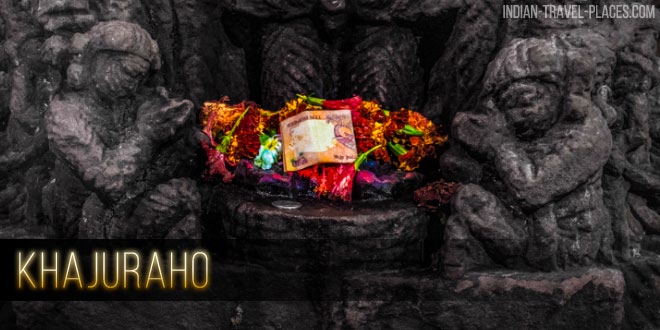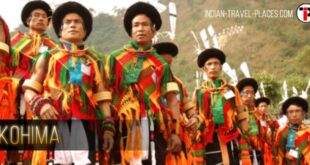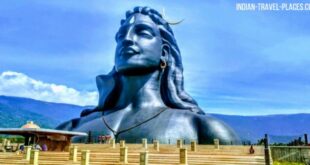| Name: | Khajuraho – Land of the Moon God “खजुराहो“ |
| Location: | Chhatarpur District, Madhya Pradesh, India |
| Climate: | Summers: 47° C (Max), 30° C (Min) | Winters: 28° C (Max), 4° C (Min) |
| Best Time To Visit: | October to April |
| Nearest Airport: | Khajuraho Airport |
| Railway Station: | Khajuraho Station |
| Must Visits: | Western Group of Temples, Eastern Group of Temples, Southern Group of Temples |
| Language Spoken: | Hindi, English |
| STD Code: | 07686 |
Khajuraho is a small town located in the Chhatarpur District of Northern Madhya Pradesh, India. Also known as the ‘Land of the Moon God‘, Khajuraho is renowned world over for its group of monuments that have survived centuries of timeline to be where they stand today. These groups of medieval Hindu and Jain temples, famous for their erotic sculptures, carved with human hands, have even been recognized and listed by UNESCO as a World Heritage Site, and are considered among the seven wonders of India. However, these temples differentiate themselves as depicting eroticism instead of worshipping deities like any other temple city of India. Scattered over an area of 20 square kilometers and elevated at 283 meters (average), these temples are set against the picturesque backdrop of Vindhya Range of mountains, sculptures of which represent the Indo-Aryan architecture of the medieval times and manifest Indian aesthetics.
The town’s name of Khajuraho comes from the Sanskrit word of Kharjur, meaning date palms. History has it that the Moon God, driven by passion, seduced and ravaged a beautiful Brahmin girl called Hemvati, resulting in a son that was conceived by her and named him Chandravarman (founder of chandela dynasty). Later in a dream, Chandravarman was asked by his mother to build a temple which would reveal the treasure of passion and erotic fantasies to the world. These temples were, then, built between 950 Century AD and 1050 Century AD, under the reign of Chandela Dynasty of Central India. But later, with the fall of the Chandela Dynasty, these temples were hidden over dense date palm trees and were lost in ruins. It was in 1838 that a British army engineer, Captain T.S. Burt rediscovered them. It is believed that about 85 temples had been made but only 22 survived. In 1986, the place was declared a World Heritage Site.
The tourist attractions include these majestically carved temples that have been grouped as Western Group of Temples (the largest), Eastern Group, and Southern Group; with each temple carrying a different connotation with itself. Western Group comprises of Kandariya Mahadeo, Chaunsath Yogini, Chitragupta Temple, Vishvanatha Temple, Lakshmana Temple, and Matangeshwara Temple. Eastern Group comprises of Parsvanatha Temple, Ghantai Temple, Adinatha Temple, and Brahma temple. And the Southern group with just two temples, Duladeo Temple and Chaturbhuja Temple. Moreover, there’s a light and sound show narrated in the voice of iconic Indian actor, Amitabh Bachchan. Tourists can also indulge themselves in shopping of iron, brass and stone sculptures depicting Kama sutra poses. There’s also a government authorized crafts emporium which deals in gold and silver ornaments and sandstone statues. Khajuraho is also well linked through roadways with the neighboring cities of Jhansi, Gwalior and Bhopal etc. It is also well connected to all the major cities of India through railways and airways. No wonder it’s the second most favorite tourist destination in India, after Taj Mahal.
Best Time To Visit:
Khajuraho, the heritage hub of India, is studded with stunning temples that simply wows you with its erotic sculptures and impeccable architecture. Each shrine laid down in this city is unique and oozes with aesthetic appeal. The backdrop of this scenic place has not just enticed tourists but has also grabbed the attention of many renowned filmmakers across the world. As you walk along the streets, you can find many lodges, hotels and bike shops from where you can rent bicycles to explore the whole city and get an insight into the rural life of Khajuraho. There are three sets of temples in the town, subdivided into eastern, western and southern. Among all, the western group of temples is believed to be the most splendiferous of the lot. On your visit to this place, don’t forget to catch up on the light and sound show that is conducted here daily. The weather in Khajuraho is tropical and marked by blazing summers, moderate monsoons and cool winters. To know more about the weather conditions and the best time to visit Khajuraho, scroll down the article further.
When To Go:
Summer
Summers in Khajuraho are stuffy and sweltry, thus, making it an extremely unfavorable period for you to venture out or go for sightseeing. March marks the onset of summer and lasts uptil May, with pre-monsoon showers mellowing out the blazing heat to some extent. The maximum summer temperature experienced by the town is 470 C. If you travel to Khajuraho during the blazing summer months, make sure to wear light cottons and carry umbrella or hat to save yourself from the stewing sun. Not just the days but also the nights can get quite sultry during the summers here.
Monsoon
Monsoon embarks on the city in the month of July and lasts until September. This period is characterized by heavy rainfall and frequent bouts of drizzle. The annual amount of rainfall received by the town here is 114 cm. During the time of monsoon, the local inhabitants remain indoors and although the city receives many visitors during this time, this is definitely not an appropriate time to hit the town. Tourists visiting Khajuraho during monsoon must carry raincoats and umbrellas along with them.
Winter
Just like extreme summers, even winters are marked by quivering cold with temperature dropping to 4oC at times. November, December, January and February are the winter months in Khajuraho. While the days are generally warm, the nights can get nippy. Local people during this time prepare hot dishes and soups to keep themselves warm. Winter is an ideal time to visit Khajuraho and explore its heritage sights. However, don’t forget to carry lots of moisturizers and cold creams since the climate tends to get a bit dry during the winters, which in turn may lead to itchy skin, rashes, etc.
Opting For Your Favorite Season
As summer and rainy season aren’t the right period to explore Khajuraho, the best time to opt for is either during the wintertime or during the months of September to March. If you happen to travel to Khajuraho in the months of February and March, don’t forget to check out the weeklong Khajuraho Dance Festival. You will be awe-struck by the splendid classical dance performances showcased by the country’s best dancers. The local people based in Khajuraho are friendly and predominantly speak in Hindi. Some of the travel guides can even converse in French, English and Dutch. So, communication is never a problem in this place.
Things To Do
When in Khajuraho, you will never run out of things to do. Apart from hiking down the city temples, you can entertain yourself to the stunning light and sound show that is held here every evening. What’s more, Khajuraho boasts of great souvenir shops that sells antiques, gems, handicrafts, stone and bronze sculptures and more. Once you are done with touring the city temples, you can hit other attractions like the Archaeological Museum, the massive Ajaigarh and Kalinjar Fort and other hotspots in and around Khajuraho.
History:
India is a fascinating country with each of its cities boasting of spellbinding tales of its past, buttressed by perplex writings on ancient palm leaves and its mythical chronicles that are still a mystery to human minds. The history of Khajuraho is no exception to this. Khajuraho history centers on numerous stunning temples that have withstood the test of time for several centuries. The temple town of Khajuraho lures tourist by its matchless structural brilliance and sculptural distinctiveness that is hard to find elsewhere. A UNESCO world heritage site, Khajuraho has many Hindu and Jain temples that display the sexual open-mindedness of the people during the medieval era. The monuments in the region were mainly the brainchild of the Chandelas. The shrines, mostly modeled after the Nagara style of architecture, show the artistic exuberance of the South Indian dynasty. The city once possessed 85 different places of worship but sadly today, only 22 of them remains. To know more about the history of Khajuraho, read on.
Khajuraho History:
Ancient History
There are several viewpoints on the origins of the place. According to the ancient anecdotes narrated by Chandbardai, a court poet, Hemvati, the daughter of the high priest of Kashi, who was known for her matchless beauty, was bathing in a pond. Seeing her impeccable beauty, the moon god couldn’t resist himself and took a human form to ravish her. The aggrieved maiden threatened to curse the moon god but the god decided to make amends for his faults by blessing her with a heroic son who was born in Khajuraho. The infant was named as Chandravarman, a valiant warrior, who built several temples and shrines in and around the region. According to the prophecy of the moon god, Chandravarma performed a ‘yagya’ (a sacred ritual) so that Hemavati could get rid of her sin. This was how the place came into existence. However, many historians find the story uncredible and relate the origin of the city to the Chandelas. After a nomadic tribe attacked the northern region of Mleccha, the Bargujar Rajputs moved towards the central plain of the continent and settled as Bundelas and Chandelas. The Bargujar Rajputs were the ones to construct the famous Kalinjar fort in the nearby region of the temple-city. Later, they erected many outstanding architectural pieces within the province that eventually went on to immortalize the city of Khajuraho.
Medieval History
During the medieval period in the 10th and 12th century, the Chandelas ruled the place. The city of Khajuraho was the cultural hub of the Chandelas while the Kalinjar fort served as their political centre. The district of Khajuraho prospered over a period of 200 years, with several holy shrines springing up. Under the leadership of Chandelas, the place continued to flourish. However, once the capital was shifted from Kalinjar to Mahoba, the prosperity of the Khajuraho began to wane. Apart from the Chandelas, the place also saw influences of several other kings who contributed to the art of sculpting in the region by adding several other temples.
16th to 19th Century
The temples of Khajuraho were developed over a period of many centuries and were much treasured by its kings and its local inhabitants, who took great measures to protect the temples from Mughal invasion. The descendents of the ruling kings feared that the temples would be demolished. The place was covered up by thick vegetations and was hidden by an oasis of greenery. In the 19th century, the city again resurfaced when the local people led an Englishman to the lost city of temples. By 1835, the Asiatic Society of Bengal published a detailed description of the shrines in the region. The record was written by Captain T. S. Burt and English engineer. By 1864, Khajuraho underwent several restoration work conducted by the Archeological survey team of India. In 1953, after Indian Independence, the monuments of Khajuraho were passed under the surveillance of the ASI. Today, these temples stands as an exemplary model of artistic refinements of the Indian kings.
How To Reach Khajuraho:
If you think a piece of stone cannot express, wait until you set your eyes on the sensuous stone sculptures in Khajuraho, evincing the different moods of a woman, and you will know how animate stones are. Lionized for its sensuous sculptures, the baroque stone carvings in Khajuraho temples are a stupefying sight that just promises to leave the observers entranced. The place boasts of some of the best Hindu and Jain temples, each of them delineating the different emotions of a woman. The sculptures embody the matchless architectural skills, the marvelous esthetic sense and the majestic artistic influence of its builders. The quaint, rural town of Khajuraho is replete with scores of temples and heritage sites. In fact, most of the temples that you see here are all listed under the UNESCO World Heritage Site and is deemed as one of the many wonders in the world. Today, Khajuraho is an important place in the tourism map that attracts hordes of travelers to this part of the country. Read the article to know more about how to reach Khajuraho and make your trip memorable.
Traveling:
By Air
Although the town does not have an international airdrome, the domestic terminal in Khajuraho is one of the busiest in Chhatarpur district. Some of the domestic airlines operating from Khajuraho are Jet Airways, Air Sahara, Kingfisher Airlines, and Air India. These airlines connect Khajuraho to the cities of Delhi, Mumbai, Varanasi, Agra, Bhopal and Indore. International passengers can avail Mumbai or Delhi airport to reach Khajuraho. Travelling through air is the best option for those looking at saving time and willing to forego a bumpy road ride.
By Rail
Until 2008, people traveling to Khajuraho had to depend on the closest rail junctions of Harpalpur (94 km) and Mahoba (63 km) to reach the place. However, with the formation of a new railway station, traveling to Khajuraho by train has become more convenient than ever. If you are traveling from Delhi, Bangalore, Chennai or Trivandrum, then the best feasible option for you would be to reach Khajuraho via Jhansi. Jhansi railhead that is connected to the major Indian cities by Dakshin Express, Jhansi-Allahabad Passenger and Bhopal Shatabdi Train. Satna Station, situated on Allahabad-Mumbai line, is the best alternative route for passengers traveling from Mumbai, Kolkata and Varanasi.
By Road
The roadways are also another good option to reach Khajuraho. Numerous buses make a routine stopover at this town and connect it to the cities of Jhansi, Mahoba, Sagar, Harpalpur, Allahabad, Agra, Satna, Gwalior, Jabalpur, Indore etc. Many A/C and non-A/C buses function in this region and are set by the Madhya Pradesh government in order to promote tourism. If you are looking for a cheap and comfortable means of transport to Khajuraho, then you must consider using the local buses. However, if you have a few extra bucks to spare, then better hire a taxi, which is a far better option than taking the grueling bus rides.
Getting Around
If you are looking for the best means to travel around and explore Khajuraho, then forget car and bike and pedal around the city. You can always rent a cycle from any local bike shops. Alternatively, you can opt for cycle rickshaws that are cheap here. However, if you wouldn’t really like to go low on comfort and luxury, then there are several travel services that offers cars in rent.
Tourist Attractions In Khajuraho:
Inspiring architecture and erotic sculptures of temples makes Khajuraho the most sought-after tourist destinations in India. The temples of Khajuraho undoubtedly stand as graceful examples of medieval and ancient architecture and proudly display the creative boom of the bygone era. The sensuous stone carvings, aesthetically inscribed in the walls and facades of the temples, wows the visitors with their sheer beauty. As per the records, the construction of these temples started in the middle of the 9th century and it took almost four centuries to finish the work. Although Chandela Rajputs were the ingenious inspiration behind the grandeur of the Khajuraho temples, many other noted sculptors and artisans contributed their whole life in bringing the sculptures to perfection. Besides exemplary temple designs, Khajuraho holds great interest for the archeologists, as the land serves as the witness to some of the glorified rules and their stunning monuments. If you want to explore the grandiosity of artistic India, then there is no better place than Khajuraho. Go ahead and enjoy the writing to know more about tourist attractions in Khajuraho.
Places To Visit In Khajuraho:
Eastern Group Of Temples
The eastern group of temples, sited on the outskirts of Khajuraho, exemplifies the sculptural ostentation and unfathomable beauty of the architectural designs in the Temples of Khajuraho. The temples here are subdivided into two groups — one representing the finest designs of Jain temples and the other dedicated to Hindu gods and goddesses. The eastern group of temples, which include the temples of Parsvanath, Ghantai, Adinath, Vamana, Brahma, Javari and Hanuman, with their mind-boggling artistic masonry depicting gods, goddesses, musicians, warriors, real and mythological animals, emblematize the love of Chandelas for extravagantly embellished structures.
Western Groups Of Temples
If you wish to experience the true splendor of Kamasutra carvings that swaddle the temples of Khajuraho, then rush to the western group of temples. Established by the royal faces of the country, the temples are clubbed together within a huge compound. Including Lakshmana Temple, Kandariya Mahadeo Temple, Devi Jagdamba Temple, Chaunsat Yogini, Chitragupta Temple and Matanageswari Temple, the western groups of temples in Khajuraho boast of some of the most impeccably embellished and erotic structures that are a real treat to the eyes.
Southern Groups Of Temples
Exquisitely designed temples of southern groups, located at a distance of 5km from Khajuraho, mainly consists of two temples, namely Dhuladeo temple and Chaturbhuj temple. Among the two, the Dhuladeo temple dedicated to Lord Shiva was established between 1100 and 1150 AD. The architecture of this temple is renowned for its innovatively designed mandapa, antarala and garbha griha. The Chaturbhuj temple is dedicated to Lord Vishnu and displays brilliant artistic features.
Khajuraho Archaeological Museum
Khajuraho, the temple city of India, serves as a paradise for archeologists and tourists who are interested in history and heritage. Khajuraho Archaeological Museum gives you a glimpse of historical inheritance of the past. In the year 1910, a local British government officer, W E Jardine piled up rare collectables from temples of Khajuraho and preserved them in a building near Matanageswari Temple. Until 1952, this collection was known as Jardine Museum. The repository was later renamed as Khajuraho Archaeological Museum by the archaeological survey of India. Today, with nearly 2000 rare objects to its name, the museum is a must visit place in Khajuraho.
State Museum Of Tribal And Folk Art
State Museum of Tribal and Folk Art in Chandela Cultural Complex of Khajuraho display the tribal tradition and folk arts of the region that has evolved over the centuries. With nearly 500 masterpieces of metal craft, woodcraft, terracotta, folk paintings and jewellery, the museum symbolizes the beauty and creativity of Indian artisanship. If you like to have a look at the artifacts displayed in the museum, then you can visit it on any days except on Mondays and government holidays.
Shopping In Khajuraho:
Madhya Pradesh’s most enviable city, Khajuraho whose main claim to fame are its stunning temple complexes swathed with sensational stone sculptures, is truly every art lover’s ultimate stop. It’s no surprise that this city of moon god has been adjudged as world heritage site owing to its impeccable collection of magnificent shrines. Besides local tourists, even foreigners flock to this land to discover and capture its magnificent splendor and experience real India. Besides its string of baroque temples, Khajuraho is dotted generously with sophisticated resorts and lodges that apparently boast of superlative services. Shopping and exploring the wide alleys here is equally gratifying. Every lane is endowed with shops loaded with local handicrafts and stone-carved replicas of erotic sculptures. Also, if you are lucky enough, you can stumble upon some vendors selling local knick-knacks that makes for incredible gift items. The best time to make a visit to this renowned tourism spot is anytime between September to March. Scroll down the write-up to know about the top shopping places in Khajuraho.
Things To Buy:
Textile And Saris
Khajuraho is famous for variety of saris and textile products. Emporiums and apparel shops have a well-stocked collection of clothes and saris infused with delicate patterns and designs. Almost all the major shopping complexes sell Indian wears and other related stuffs to appease their customers. Hit the souvenir shops located near the entrance of the famous ‘Western Group Of Temples’ to pick up embroidered kurtas and colourful dupattas at throwaway prices.
Miniature Stone-Carved Replicas
Khajuraho, the land dotted with titillating sculptures is well known for its stone-carved replicas of exotic figures that arouse your senses with their sensuous composition and pose. Many bazaars and gift shops are loaded with the statues that sell like hotcakes and grab the eyeballs of every tourist.
Silver And Brassware
For purchasing fascinating silver and brasswares, you can head over to Rajnagar, which organizes weekly bazaar on every Tuesdays. Even though the products are very reasonably priced, it’s always advisable to put your bargaining skills to the optimum use. Evenings generally get crowded, so better reach the place early and pick the best item. Rajnagar is situated just 5 Km off the main town can be easily reached from Khajuraho via local buses.
Traditional Handicrafts
Local artifacts and handicrafts are another popular selling souvenir in Khajuraho. Emporiums and handloom stores are the safe place to step inside to purchase the craft wares. A place called Craft Emporium nestled in Hotel Gem Palace on Jain Temple Road sells a spectacular range of sand stone figures besides other products such as brasswares, tribal artifacts, and paintings among others. Another good place to visit is Mrignayani located near Gole market.
Jewelry
Besides handicrafts and miniatures of stone sculptures, the lively markets of the city are also filled with street stalls selling funky jewelry items like silver rings, necklaces, bracelets, pendants, etc. Karan Jewelers, Chandela Emporium and Krishna Jewelers placed in the heart of the city are some of the popular shops to buy jewelries.
 ITP Indian Travel Places: Food, Travel, Tourism Business Events and Trade Shows
ITP Indian Travel Places: Food, Travel, Tourism Business Events and Trade Shows








One comment
Pingback: World Heritage Sites In India - Kids Portal For Parents